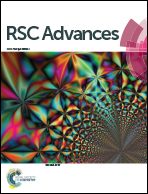A green l-cysteine modified cellulose nanocrystals biosorbent for adsorption of mercury ions from aqueous solutions†
Abstract
Using a green biosorbent to remove toxic mercury ions from aqueous solutions is a significant undertaking. In the present study, a novel biosorbent, L-cysteine modified cellulose nanocrystals (Lcys-CNCs), was prepared by functionalizing high surface area cellulose nanocrystals with L-cysteine through periodate oxidation and reductive amination reaction. Lcys-CNCs were characterized by FT-IR, 13C CP-MAS NMR, elemental analysis, XPS, zeta potential and SEM. As cellulose nanocrystals are the natural nanomaterial, and L-cysteine contains strong mercury chelating groups, Lcys-CNCs show excellent adsorption capacity for mercury ions. The experimental conditions such as pH, contact time, and initial mercury ion concentration are discussed. The pseudo-second order model can describe the removal kinetics of Hg(II) more accurately than the pseudo-first order model. The adsorption isotherm study of Hg(II) followed the Langmuir model of monolayer adsorption. The maximum uptake capacity of Lcys-CNCs was determined to be 923 mg g−1. Lcys-CNCs can remove mercury ions with 93% removal efficiency within 5 min from a 71 mg L−1 solution. For Cd(II), Pb(II), Cu(II) and Zn(II) ions, Lcsy-CNCs can selectively adsorb Hg(II) ions and the removal efficiency is 87.4% for Hg(II). This study suggests Lcsy-CNCs are a green and highly efficient biosorbent for adsorption of mercury ions from aqueous solutions.



 Please wait while we load your content...
Please wait while we load your content...